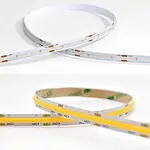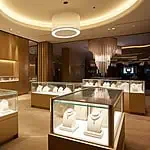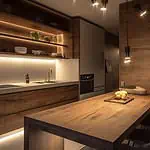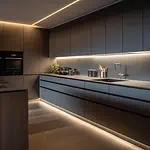Under cabinet lighting works great for providing sufficient illumination for task lighting. Apart from this functionality, you can also target under cabinets for accent lighting. But where should you place the fixtures- in the front, back, or middle of the under cabinet?
The right placement of the under cabinet lights depends on your lighting needs. For instance, if you want sufficient illumination for task lighting, the front of the under cabinet is the best location for this. Again, for accent lighting to enhance the outlook of your cabinet, go for the back of the under cabinet. And when you can’t decide on the location, the safe option is to install fixtures in the middle of the cabinets. Besides, you should also consider other factors like- bulb size, the distance between the fixture, etc., to find the light placement.
However, LED strips, puck lights, or stick under-cabinet lighting have their own sets of rules for placement under cabinets. There is nothing to worry about; I will discuss all the facts you need to know for the right placement of under cabinet lighting. At the end of this article, you will also find guidance on installing under cabinet light in the right location. So, let’s get into the discussion without any further delay-
What Is Under Cabinet Lighting?
Under cabinet lightings are installed underneath the cabinets, shelves, or similar surfaces to provide sufficient illumination for tasking. LED strips, puck lights, and mini bar lights are the most popular variants of under-cabinet lighting. Unlike traditional fixtures, these lights have a minimalistic design that fits the little space under the cabinet and provides a hidden lighting effect. Apart from task lighting, under cabinet lights also work great for accent lighting. You can install these in different ways depending on the layout and thus enhance the look of your interior.
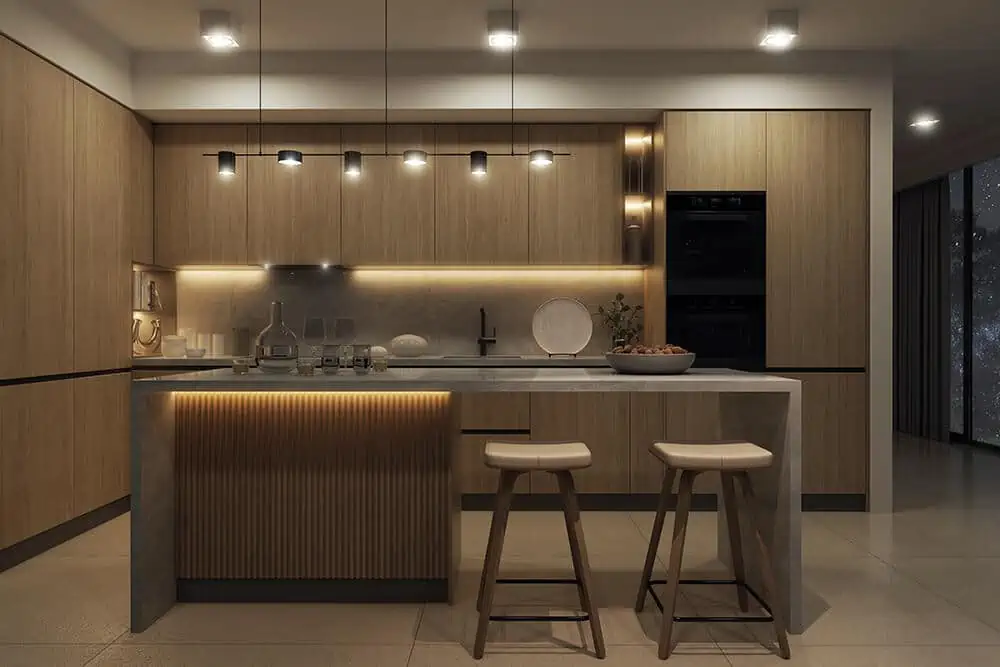
Why Is The Right Placement Of Under Cabinet Lighting Important?
The correct placement of under-cabinet lighting significantly improves the functionality and aesthetics of your area, commercial or home. Let’s see the importance of placing the under-cabinet fixtures correctly-
- Task Illumination: Under-cabinet lighting serves as task lighting. For instance, the undercabinet lighting of the kitchen aids in proper visuals while chopping vegetables, reading recipes, or preparing meals. Thus, with correct placement, you can ensure that the light is directed where needed to enhance visibility for these tasks. To learn more about kitchen lighting, check this- How To Choose the LED Strip Lights For Kitchen Cabinets?
- Ambiance And Mood Enhancement: Well-placed under-cabinet lighting contributes to the overall ambiance of the space. For this, tunable white LED strip lights work best. You can use warm lighting when doing relaxing tasks in the kitchen, like refilling your grocery items. This will create a warm and cozy mood. Again, switch to cool light for proper visualization when doing tasks like chopping or cooking. This way, you can enjoy the perfect lighting while doing any task in your kitchen. However, there is more to know about how light can affect your mood; read this for details- How To Use LED Light Colors For Different Moods?
- Highlighting Design Features: Properly placed lighting can accentuate the architectural and design features of your cabinets, countertops, and backsplash. With it, you can draw guests’ attention to these elements and increase the visual appeal of your space.
- Minimizing Glare And Shadows: Placing under-cabinet lighting in the right place helps minimize glare and shadows. This is especially important in the kitchen as sharp knives are often used there. So, with adequate lighting, you can reduce the chances of accidents and get a clear view of the workspace.
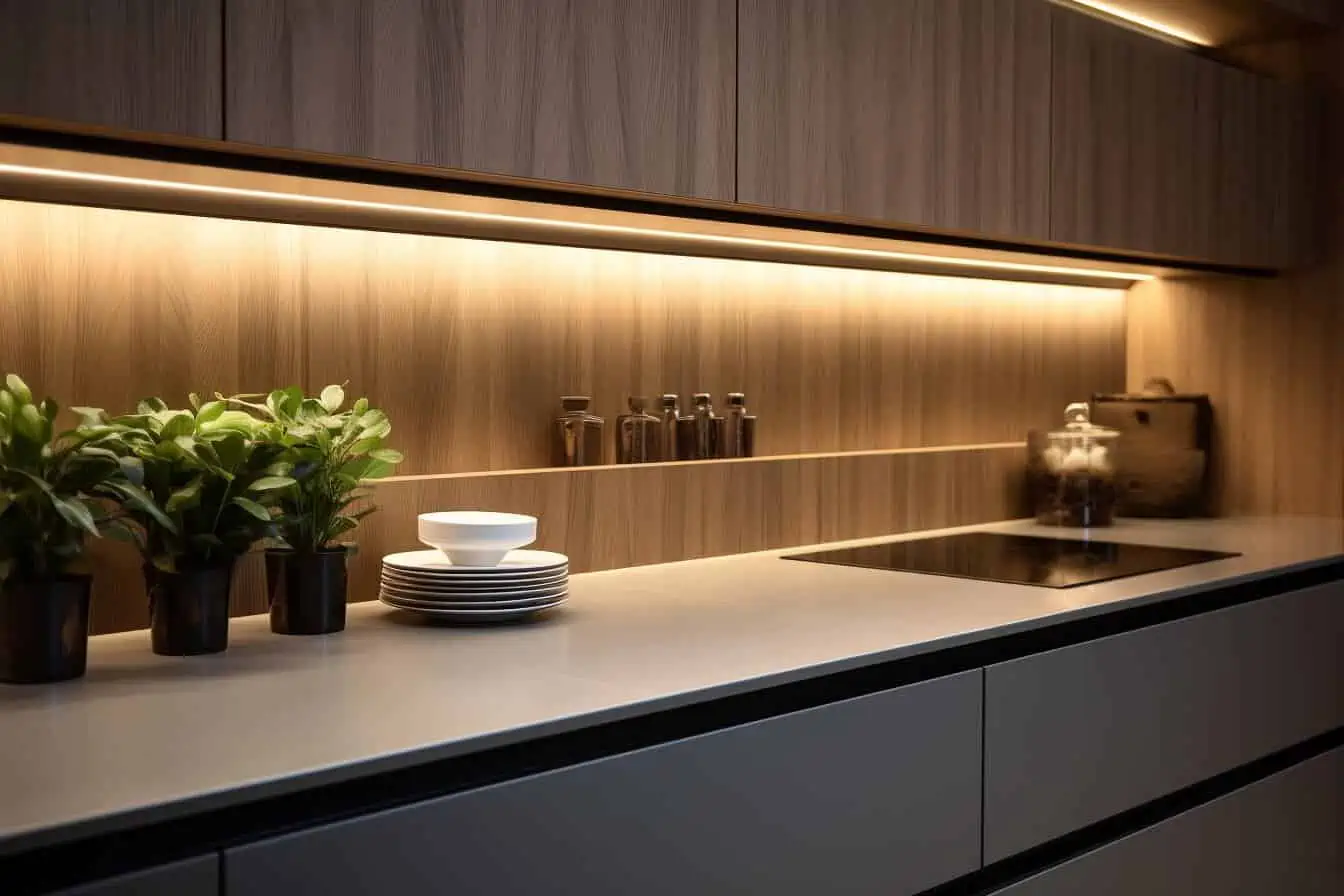
Rules For Placing Under Cabinet Lighting
You should know some basic rules for placing lighting under the cabinet to get the best output. For instance, if you choose puck lights, considering their beam angle and size is essential. Likewise, there are a few more rules that you need to know. So let’s explore them-
Rules For LED Strip Lights
LED strip lights are an excellent option to replace liner lights. They come in different widths and diode sizes, which you should consider when deciding on the right place to install them. For instance, LED strips with bigger diodes can cover more space, so you can place them in the middle to illuminate the entire under-cabinet section. Again, if you want to focus more on accent lighting, using thinner LED strips is okay. In this case, install them to the end or back of the cabinet to get a hidden accent lighting effect. However, consider the LED strip density while choosing light for cabinets. Low-density LED strips will cause a hot spot effect, which may not look good. Besides, if you set them too close to the front, they might create bright spots on your counter. Hence, before placing them, it’s a good idea to check by moving the light strip from the back to the front to find the best spot.
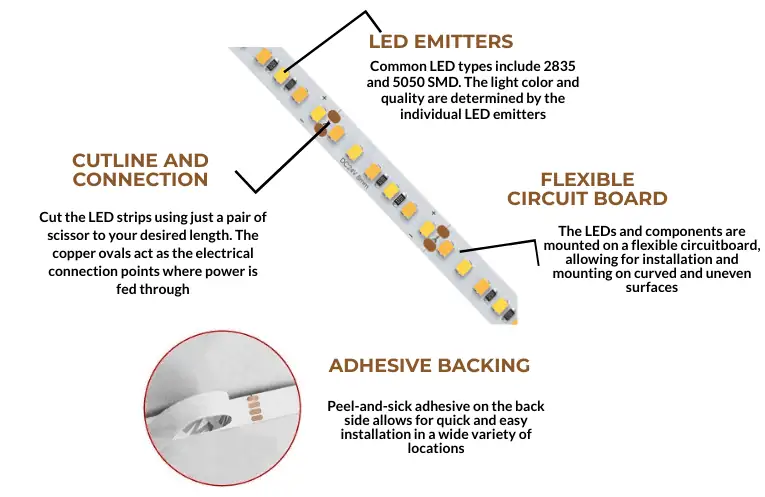
Rules For Puck Lights
When using puck lights for under-cabin lighting, the main issue that arises is deciding on the distance between the lights. In this case, you need to consider the length of the undercabinet’s cavity, the light’s beam angle, and its brightness. The number of puck lights required and their distance depend on the fixture’s beam angle. The beam angles of puck light usually range from 20 to 120 degrees. You will find the beam angle of your puck light on its packaging. The general rule of thumb here is to place 90-degree puck lights around 20 inches apart, giving you beams that overlap by about 50%. Besides, the cavity of the undercabinet is also a crucial consideration. The below chart shows you the number of puck lights you need to install for varying under cabinet cavity lengths-
| Length Of Cavity | Number Of Puck Light |
| 6-10 inch | 1 light |
| 11-18 inches | 2-3 light |
| 19-26 inches | 3-4 light |
| 27-34 inches | 4-5 light |
| 35-42 inches | 5-7 light |
| 43-50 inches | 6-8 light |
Rules For Stick Lights
Linear lights, also known as bar lights and stick lights, are excellent options for under-cabinet lighting. The best part is putting the stick light at the front edge of the cabinet, which lets you hide the wires and keep the light itself out of sight. Using these fixtures, you can bring uniform lighting to your countertop and backsplash of the cabinets. And for the best outcome, you should focus on matching the length of the stick light to the counterpart. Stick lights are usually sold in regular-length increments. For instance, you will find them as 8 inches, 16 inches, 24 inches, or 32 inches. Now, if the cavity of your under cabinet is 18 inches, select a 16-inch stick light instead of an 8-inch one. That is, the rule is to match the length of the cavity to the fixture as closely as possible.
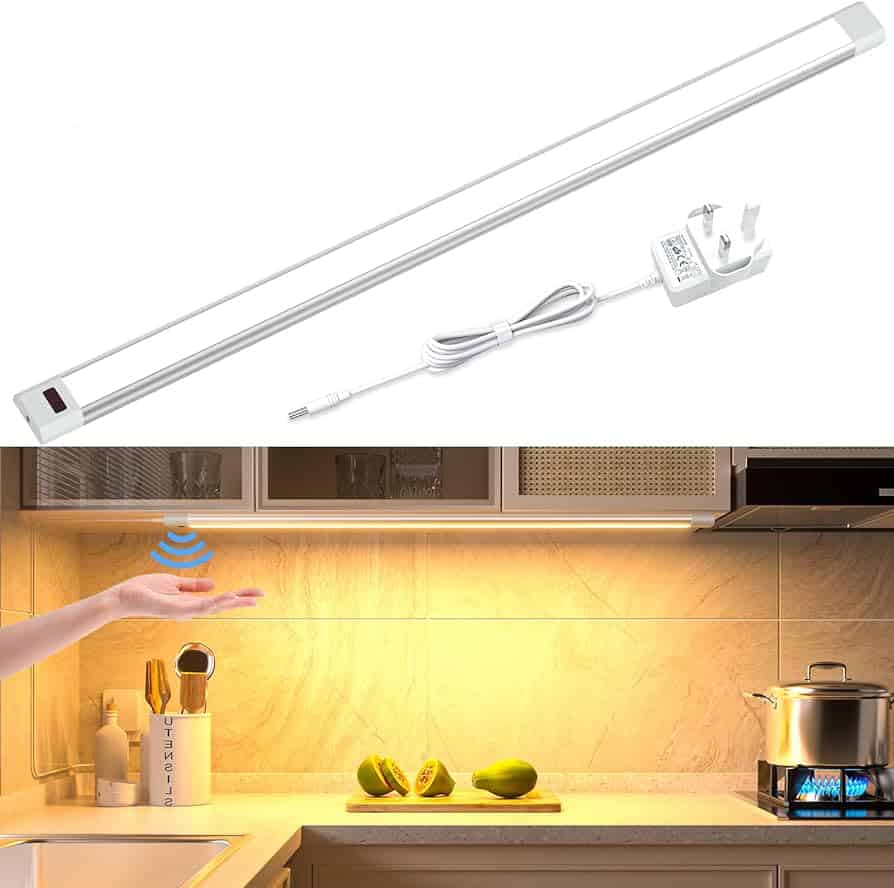
Location To Place Under Cabinet Lighting
There are three locations you can decide from; read the section below and find out which one you like–
Front Of The Cabinet: Best For Task Lighting
Putting lights in the front of your cabinet works best for task lighting. This way, you can ensure more light goes to the front of your counter and less to the wall behind it. Thus, it will provide sufficient illumination when you chop vegetables or do other food preparation tasks on the counter. LED strips and stick/bar lights are the best choice for front cabinet lighting. You can install them following the inner boundary of the under cabinet. However, any railings in front of the cabinet may hide the fixture, which can cause shadow issues. In this case, installing the fixture 2-3 inches backward would be enough. Nevertheless, if the railing is designed in such a way that you can easily insert the LED strips on its inner side, don’t miss to take advantage of it. Such an under-cabinet light installation will hide the fixture and bring elegant accent lighting.
Back Of The Cabinet: Works Okay For Accent Lighting
If you install your lights at the back of the cabinet, the wall behind your kitchen counter will be well-lit. But the front of the counter won’t have as much light. Don’t put the lights at the back of the cabinet if you need good light for cooking and other kitchen activities. Instead, you can place them closer to the front. But when your kitchen has sufficient ambient lighting, and you want to focus more on accent lighting, the back of the cabinet is your go-to location. For accent lighting, you can choose warm-tone LED strips that bring a cozy vibe to your space. Besides, you can also experiment with colorful LED strips like- turquoise, orange, pink, blue, or something that goes with your interior. Check this to find the best light color for your kitchen cabinet. How do you choose the right color lighting for a kitchen?
Middle Of The Cabinet: Bring Lighting Balance
Placing the lights in the middle of the cabinet will share the light evenly between the backsplash and the front of your counter. It also balances task and ambient lighting. If you’re unsure what to do, putting the lights in the middle can be an amicable middle-ground solution. When you put the lights under the cabinet in the middle, you’ll still have enough light on the front of your countertops. Thus, it aids in both accent and task lighting. However, consider the size and brightness of the fixture you install. Ensure the fixture you place in the middle of the undercabinet is bright enough to illuminate the entire underneath space evenly.
However, if your countertop is made of shiny material like marble or tiles, avoid using fixtures under the cabinet that are too bright. This will cause replication issues. In this case, if you are using puck lights, use small lights with wider beam angles; this will diffuse the light without causing major reflection issues. Again, I suggest you go for a medium-level lumen rating with a wider strip length for LED strip lights. Thus, you won’t face reflecting issues but will have sufficient lighting for tasking. In this case, the size of the LED chip is also a crucial factor in selecting the ideal LED strip. Bigger LED strips can give greater illumination. Check this article to learn more- Numbers and LEDs: What Does 2835, 3528, and 5050 Mean?
Considerations For Right Placement Of Under Cabinet Lighting
Let’s see here some of the factors you need to consider while searching for the right placement for under cabinet lights–
Available Space
First, find a suitable space, but you must avoid the back wall when placing lights. However, you can think about creating an ambient placement; it only causes light loss. Also, it can be the reason for shadows, especially if your backsplash has a textured surface. Besides, a lot of lights have a wide beam that spreads out. If you put it against a back wall, you’ll lose the focused light that’s good for working under cabinets. Sometimes, lights have a 45-degree angle, and it’s fine to mount them at the back of upper cabinets so they shine outward.
Distance From The Counter Surface
You must consider the distance of the under-cabinet area to the counter surface to ensure sufficient brightness. If you use a low-lumen bulb that doesn’t cover the distance, you won’t get proper illumination for tasking. For example, if you slide your hand from the back to the front of the cabinet on the counter, you’ll notice the light going down and then up again. And you obviously want most of the counters to get the brightest light, right? However, most kitchen cabinets are about 18 to 24 inches from the counter to the bottom of the upper cabinets. So, regular LED lights might not give enough brightness in that space. For instance, if you use a 3-watt LED puck light with 200 lumens placed 36 inches away from a surface, you’d only get around 10-foot candles.
Size Of Your Fixture
Do bigger fixtures illuminate large spaces? No, how much area your fixture can cover depends on the beam angle of the fixture. Installing a bulky fixture under the cabinet will look odd. In this case, go for small lights with a wider beam angle. This will illuminate large spaces, keeping the physical appearance of the fixture minimal. However, when you install small recessed lights, the distance between fixtures must be reduced to ensure sufficient light. Installing large lights is fine with increased distance. On the other hand, when using LED strips, it is essential to consider the width; LED strips are available in various widths. Wider strips provide more prominent lighting. To learn more about different strip widths, check this: What LED Strip Widths Are Available?
Voltage Ratings & Power Source
When installing a fixture under the cabinet, a common question that might knock your mind is how to power the lights. Nothing to worry about; if there is no available power source near the cabinet, go for battery-powered lights. USB LED strips are also available to save you from plugging hassles. If you want to know more about alternative options that don’t require plugins, check this: How To Use LED Strip Lights Without Plug?
However, whether you choose a plugin light or a battery-powered one, matching its voltage to the power source is essential. For example, you can go with 12V for indoor cabinets, but for outdoor cabinets, choose 24V. Using a 12V LED strip on a 24V power source will overpower the fixture and damage it. To learn more, check this: How do you choose the voltage of the LED strip? Is it 12V or 24V?
Avoid Backlash Issues
Don’t focus on making your kitchen backsplash stand out. Instead, use the light to brighten up the space where you work on the countertop. In some older kitchens with big halogen lights, you’ll see them installed at the back of the cabinets. Certain types of lighting, like LED strips, can make your space look nice by hiding things like wires and boxes. However, it also has a downside: it will not spread light everywhere you want. With newer, smaller, and more powerful LED lights, you can put them in just the right places. This is important because if your kitchen wall has a lot of texture or the tiles have a color that doesn’t go well with the light color, your kitchen might not feel very inviting.
Hot Spot Reflection
Have you ever noticed the hot spot effect in LED strips? This might seem okay, but it is not visually appealing. This issue comes up a lot when you choose low-density LED strips. In these fixtures, the distance between the LED chips is greater. As a result, when they are lit, the light from individual chips creates a spot-like effect known as a hotspot. As countertops are mostly made of shiny materials like marble or tiles, these hot spots are reflected in these surfaces, causing glaring issues. Besides, you won’t get uniform lighting. But how to solve this? The best solution here is to go for high-density LED strips or COB led strip. But if you already have a low-density one, no worries; you can remove the hot spot reflection issue using diffusers. It could be a transparent or frosted diffuser- choose whatever you find best. Installing LED strips with diffusers will bring uniform lighting; thus, you no longer need to face hot spot reflection issues.
Location Of The Cabinet
When choosing a light for your under-cabinet zones, consider where your cabinet is located. If the cabinet comes in close contact with water or moisture, you need to go for a higher IP-rated fixture. For instance, purchase at least an IP44-rated bulb for bathroom cabinets. However, these ratings differ for different zones of bathrooms. Again, if you are lighting the cabinet of your closet, a low IP-rated bulb of IP20 is okay. The cabinets in these areas don’t come in contact with water, so no water protection is required. But if you are into outdoor cabinet lighting, go for a higher IP rating that can resist rain, storm, or other unfavorable environments. For details, check this- IP Rating: The Definitive Guide.
How Do You Install Under Cabinet Lighting To The Right Place?
LED strip lights are the most popular lighting option for under-cabinet lighting. So, in this section, I will talk about how you can install LED strips under cabinets. Here you go-
Step 1: Select Location & Take Measurements
First, you need to decide where you want to place the LED strips. If you are focused on task lighting, select the front of the cabinet to install lights. And for accent lighting, the back part of the cabinet works great. However, if you can’t decide where to place them, the middle section of the cabinet is a safe option to go. Once you have decided on the location, it’s time to take measurements. Using a measuring tape, note down the length of the cavity. This measurement will help you purchase the LED strips per the length requirements. To learn about the different sizes of LED strips, check this- What Are the Longest LED Strip Lights?
Step 2: Gather Necessary Tools
Now that you know how many LED strips you need, purchase them from a reliable source. For the best quality, you can check this- Top 10 LED Strip Light Manufacturers And Suppliers in WORLD. Besides LED strips, there are some more elements that you will need for the installation; these are as follows-
- Measuring tape
- Scissor
- LED strip connectors
- LED controller
- LED driver
Step 3: Cut The LED Strips
Place the LED strip in the location you want to install. Now, cut the LED strips according to the cavity length under the cabinet. Cutting these fixtures is pretty simple. You will find scissor icons in the PCB of the strips that indicate cutting junctions. Following the marking, size your strips and move to the next step. To get detailed guidance on cutting the LED strips, check this- Can You Cut LED Strip Lights and How To Connect: Full Guide.
Step 4: Clean The Surface
Cabinets in kitchen areas often accumulate dirt and oils. Placing the LED strips directly into such a dirty surface is a wrong practice as the adhesives can’t stick well. So, your LED strips can get loose and fall off. To avoid this, cleaning the surface is essential. You can use alcohol or any wet cloth to clean the space. However, make sure the surface under the cabinet is completely dry before you install LED strips. In case the surface is kept wet, adhesives will not stick to it.
Step 5: Mount The LED Strip Under The Cabinet
LED strips come with an adhesive backing, which makes installation much easier. You can simply peel off the back and press it to the surface under the cabinet. For strengthening the installations, you can also use clips. Besides, there is also the option to create a built-in installation by using aluminum channels. This will give a professional look to your cabinets. However, installing LED strips with this method requires technical skills. And it can be quite expensive to implement such an installation. Read this for an in-depth LED strip mounting guide- Installing LED Flex Strips: Mounting Techniques.
Step 6: Power Up The Light
Once your installation is done, it’s time to power them up. Connect the LED driver to the LED strip and then to the power source. Check the electric source’s positive(+) and negative(-) marks and connect them accordingly to your LED strips. Turn it on, and the light will illuminate. However, if it’s a battery-powered LED strip, then simply turning on the switch will work.
To learn more about LED strip installation, check this- How To Install And Use LED Strip Lights? Nevertheless, you might miss-match the voltage rating or make a wrong cut while installing. To avoid such mistakes, go through this article- 10 Common Mistakes to Avoid When Installing LED Strip Lighting.
FAQs
You can mount under cabinet lights by using screws or mounting clips. Besides, some fixtures like LED strips come with adhesive backing. Installing these fixtures is quite simple; all you need to do is peel off the adhesive tape and press it on the selected location under the cabinet.
Under-cabinet lighting has disadvantages like potential installation challenges, limited coverage for larger spaces, and the need for a power source. Also, under-cabinet lighting is mainly for lighting up the countertop. It’s not meant to brighten up the whole kitchen, so you’ll need extra lights to make the entire room well-lit.
Lights should be positioned about 12-24 inches away from the cabinet’s front edge. It will give ideal illumination for tasks like food preparation without causing shadows, which can prevent unwanted incidents. So, by maintaining the right distance, you can get sufficient light and a functional space.
The best wattage for under-cabinet lighting depends on the task and desired brightness. You can go with 1-2 watts per linear foot, which is sufficient for accent lighting. For task lighting, aim for 20-30 watts per square foot. Therefore, choose wattage based on function and space requirements for proper under-cabinet illumination.
No, hiring an electrician isn’t necessary to install under-cabinet lighting like LED strips. It’s a simple task that can be done by following the basic instructions. For example, ensure the power is off, mount fixtures securely, and connect wiring as directed. However, if you are unsure, you can consult guides.
The best way to light a display cabinet is to use LED strip lights. These fixtures are flexible and cuttable. You can size them to your required needs and install them on the edges of the cabinets to create a hidden effect. The best part is that you can even fold them in corners to ensure the light goes evenly throughout the edges of the cabinet. Thus, it enhances the appearance of your display cabinet, making your showpieces look more appealing. You will find such lighting in museums, jewelry shops, and retail stores displaying their products.
Yes, the under-cabinet placement location is crucial. The right placement of under-cabinet lighting can offer proper illumination, improving visibility and workspace functionality. On the other hand, a wrong placement can create shadows and inadequate lighting that can affect your productivity. That is why you must be careful when selecting the location for placing under cabinet lighting.
Conclusion
To choose the right location for undercabinet lighting, you first need to consider what type of fixture you are using and what light effect you want to bring. Puck lights are suitable for placing in the middle of the cabinet. In contrast, you can place LED strips and stick light to any location under the cabinet- front, back, or middle. Again, when task lighting is your priority, install fixtures on the front edge of the cabinet. And for accent lighting, go for the back part. The middle space of the undercabinet is a good location to choose if you want to bring a balance between task and accent lighting. Besides, you must consider the beam angle, size of the fixture, length of the cavity, and brightness to fix the distance between the adjusting fixtures.
However, LED strips are the most popular variants for undercabinet lighting. They don’t get hot quickly. So, there is nothing to worry about burning out your wooden cabinets due to overheating issues. Besides, the tunable white LED strips work great for cabinets as they have adjustable CCT ratings. For the best LED strips for your cabinets, place your order now on LEDYi. We have single-color, RGB, tunable white, and dim-to-warm LED lights that are ideal for your under cabinets. Besides, we also offer customizations to meet your needs. So, contact us ASAP!
